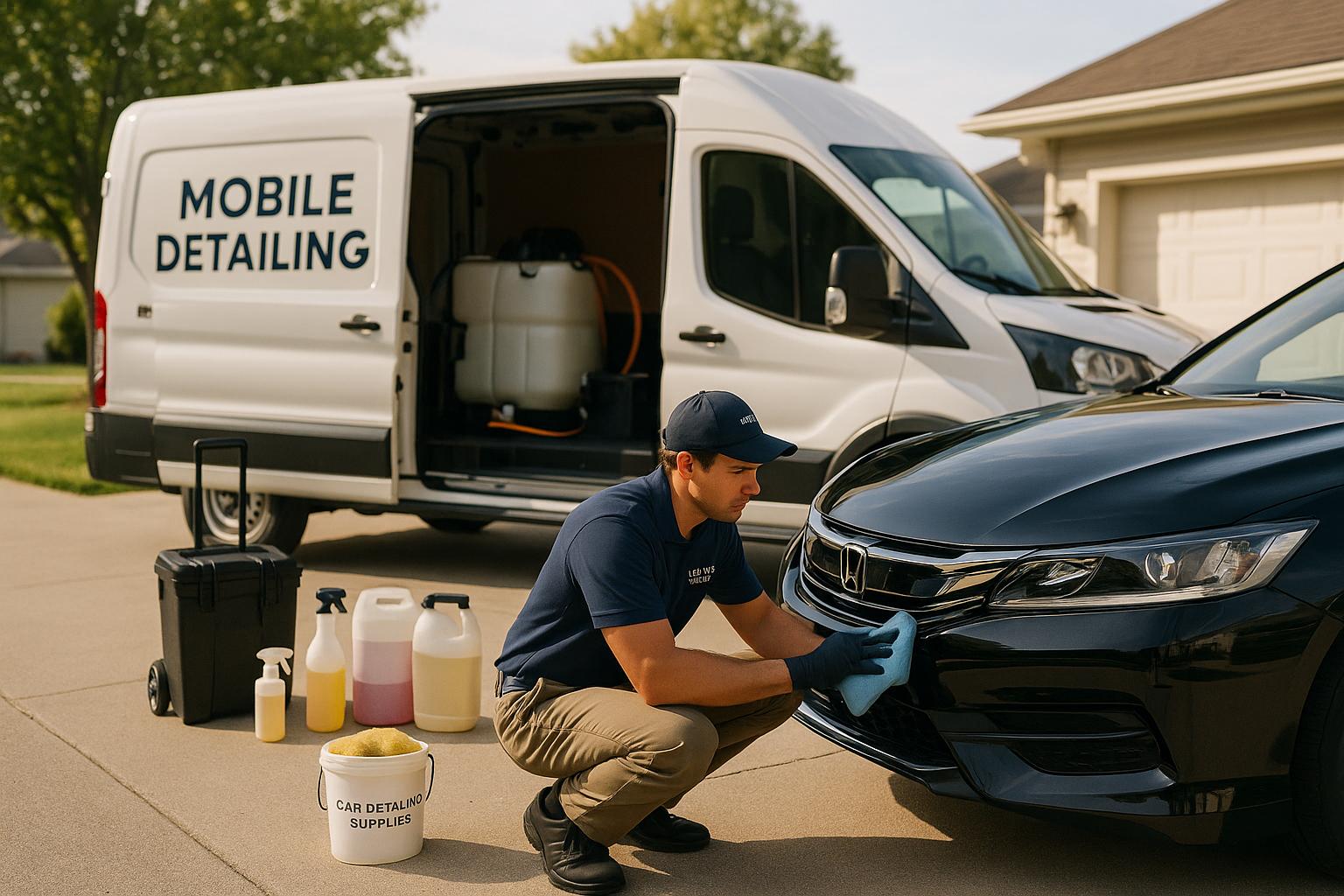
While flashy startups grab headlines, these low-profile industries are quietly making their owners wealthy. They focus on essential services, consistent demand, and recurring revenue, providing stability and long-term profitability. Here’s a quick look:
- Commercial Cleaning: $60B industry leveraging tech like robotic cleaners and eco-friendly services. Long-term contracts are key.
- Waste Management: Growing to $2.49T by 2033. Revenue streams include municipal contracts, e-waste processing, and waste-to-energy.
- Self-Storage: High profit margins (41%) with automation reducing costs. Millennials and urbanization drive demand.
- Property Management: Digital tools streamline operations, boosting efficiency by 20%. Scaling is easier with automation.
- Industrial Laundry: Reliable income from contracts with hotels, hospitals, and gyms. Smart systems cut costs and improve efficiency.
Why These Businesses Work:
- Steady demand: People and businesses need these services year-round.
- Recurring revenue: Long-term contracts provide predictable cash flow.
- Tech-driven growth: Automation and smart tools improve efficiency and profits.
- High entry barriers: Specialized equipment and expertise limit competition.
These industries prove you don’t need a flashy idea to succeed - just focus on solving everyday problems with smart strategies.
5 'Boring' Businesses Making $100K+ In 2025 (Start Yours ...
1. Commercial Cleaning
The U.S. commercial cleaning industry, valued at $60 billion, has become a thriving sector in 2025. Businesses in this space now rely on technology, eco-friendly practices, and recurring contracts to drive growth and profits.
"COVID really highlighted the front‐line workers and the job we do. It went from keeping the building clean, to keeping people safe. And it also strengthened our relationships with our customers because we went through something tough together".
Long-term contracts are a cornerstone for success. Nearly 90% of cleaning companies anticipate continued growth due to rising demand for specialized services and stricter cleaning standards. These shifts are pushing companies to refine their business models for better results.
Key Strategies for Profitability
- Tech Integration: Tools like Ice Robotics' Autonomous Floor Scrubbing Robot help cut labor costs while ensuring consistent performance.
- Increased Visibility: Cleaning during business hours provides clients with peace of mind.
- Eco-Friendly Services: Sustainable cleaning options are highly sought after, with 92% of homeowners preferring environmentally friendly solutions.
- Customized Services: Offerings like electrostatic fogging, online scheduling, tailored cleaning plans, and quality certifications meet the 66% of consumers who expect personalized services.
Modern approaches are helping businesses maintain essential service quality while improving profitability.
"I think cleaning will become more visible. We used to say, 'Our actions are invisible, but our results are visible,' but now there's more desire from our customers to really see that there is cleaning happening".
2. Waste Collection and Processing
The waste management industry is seeing rapid growth, driven by advancements in technology and a focus on sustainability. By 2033, the global market is projected to grow from $1,419.52 billion in 2023 to $2,494.59 billion, offering significant opportunities for businesses that embrace these changes.
Technology-Driven Efficiency
Smart technology is transforming waste management operations. AI-powered sorting systems and robotic automation are improving efficiency while reducing costs. These advancements are also opening up new ways for companies to generate revenue.
"By embracing these strategies and the concept of Performance Sustainability, companies in the waste and recycling industries can position themselves as service providers and essential partners in building a more sustainable and circular economy."
- Evan J Schwartz, Chief Enterprise Architect and head of enterprise foundation services at AMCS Group
Diverse Revenue Streams
With these technologies, waste management companies are tapping into a variety of income sources:
| Revenue Stream | Description | Profit Potential |
|---|---|---|
| Municipal Contracts | Long-term deals with cities for waste collection | Predictable, recurring income |
| E-Waste Processing | Handling discarded electronics | High margins from material recovery |
| Waste-to-Energy | Turning waste into electricity or fuel | Extra income from energy sales |
| Smart Collection | Using IoT for route optimization | Lower costs, higher efficiency |
Growth in E-Waste and Smart Solutions
The e-waste sector is particularly promising, with global volumes expected to reach 54–74 million metric tons by 2030. Smart bins equipped with sensors are helping companies streamline collection routes, cutting fuel costs and improving service quality.
These efficiency-focused strategies are boosting the industry's growth while supporting a more sustainable approach.
Benefits of a Circular Economy
Adopting circular economy principles could unlock a $4.5 trillion economic opportunity. Companies are seizing this chance by:
- Using advanced recycling technologies
- Developing methods to turn waste into reusable resources
- Creating new profit streams from materials that were once discarded
- Partnering with manufacturers for material recovery initiatives
One recent example is Bisleri International Pvt. Ltd.'s collaboration with the Goa State Pollution Control Board in 2024 to improve plastic waste management in Mormugao. This public-private partnership highlights how such initiatives can be both impactful and profitable.
sbb-itb-08dd11e
3. Storage Facilities
In 2025, the self-storage industry stands out as a highly profitable sector, boasting average profit margins of 41% and a 92% success rate for new businesses. With its reliance on automation and minimal staffing, it’s an appealing choice for entrepreneurs looking for dependable income.
Embracing Technology for Efficiency
Modern storage facilities lean heavily on automation to cut costs and improve service. Given the high annual turnover rate of 200% for onsite management, remote management systems have revolutionized the industry. Features like automated access control, digital leasing, AI-powered security, and smart customer service tools help reduce labor and administrative expenses while ensuring consistent service quality.
Rising Market Demand
The self-storage market is expected to grow from $59.08 billion in 2024 to $83.20 billion by 2030. This growth is fueled by urbanization, changing demographics, and a focus on convenience. Digital upgrades and eco-friendly initiatives have drawn in modern customers, keeping demand strong. To stay competitive, businesses must focus on efficient operations, as discussed below.
Strategies to Maximize Profits
Top-performing storage facilities can achieve profit margins above 50% by adopting smart strategies:
- Technology Integration
Automating administrative tasks and offering online rental systems can reduce labor costs and improve customer experience. - Efficient Facility Management
Operating expenses, typically 25-35% of gross revenue, can be managed effectively through tools like automated climate controls, predictive maintenance, remote security systems, and smart utility management.
"The days of a storage business flourishing without online rentals are in the past." - Robert Priester from StoragePug
Millennials now make up about one-third of self-storage users. With the rise of e-commerce and remote work, this demographic shift continues to fuel demand. By combining advanced technology with smart management, storage facilities remain a reliable and thriving business option in 2025.
4. Rental Property Management
With the growing influence of technology, property management is also embracing digital solutions to enhance efficiency. The industry is thriving, with projections estimating it will reach $128.3 billion by 2024.
Digital platforms are helping property managers increase efficiency by up to 20% within their first year of use. Companies like Atlas Real Estate and Evernest are prime examples of this shift. By adopting centralized communication tools and automating processes, they successfully manage portfolios consisting of thousands of units.
Atlas Real Estate, which oversees more than 9,000 units across eight states, highlights the benefits of a centralized approach. Their CEO, Tony Julianelle, shares:
"AppFolio's ability to centralize that communication in one place makes it clear to the resident what's happening and makes it clear for us on what we need to do".
Evernest, managing over 32,000 units, takes a similar approach. Founder and CEO Matthew Whitaker emphasizes the importance of automation:
"When you're growing your business, you need software that's easy to integrate and can automate as many processes as possible".
Strategies That Drive Profits
Modern property management firms are increasing profitability through:
- Workflow Automation: Streamlining tasks like rent collection, maintenance requests, lease renewals, and tenant screening.
- Data Analytics: Tracking key metrics across three areas:
- Financial: Cash flow, profit margins, and ROI.
- Operational: Maintenance expenses and response times.
- Market: Occupancy rates and rental trends.
Scaling Through Standardization
The success of MD Squared underscores the importance of standardized processes. Co-Founder and CEO Michael Mintz explains:
"It's just about doing the basics really well. And that's one of the reasons that we like AppFolio a lot. It helps our managers stay on top of the basics and do them really, really well."
As Real-Time Consulting Services puts it:
"Scaling means building efficient systems, hiring right, and leveraging technology for seamless growth."
The secret to profitability in property management lies in creating systems that support growth without requiring a proportional increase in resources or staff. By combining technology with standardized workflows, property managers are building businesses that can expand efficiently and profitably well into 2025.
5. Industrial Laundry Services
Industrial laundry services, often overlooked, are proving to be a steady source of income by combining essential contracts with modern systems. In 2025, the industry thrives thanks to consistent demand across multiple sectors.
Success Through Volume
The strength of industrial laundry businesses lies in their partnerships with a variety of industries, including:
- Hotels and resorts
- Healthcare facilities
- Athletic facilities
- University housing
- Correctional facilities
- Spas and salons
These partnerships often involve long-term contracts, creating a dependable revenue stream that grows with each new client.
Leveraging Technology for Growth
Modern industrial laundry businesses are making use of advanced technology to improve efficiency and increase profits. A great example is The Soap Box in Brooklyn. In 2021, owner Waleed Cope implemented the Cents platform, which expanded the business's delivery radius by 15 miles and integrated DoorDash for deliveries. This move not only streamlined operations but also significantly boosted revenue.
Cost-Saving Measures
To maintain strong profit margins, successful industrial laundry operations focus on key cost-saving strategies:
| Area | Strategy | Impact |
|---|---|---|
| Equipment | High-efficiency machines with 300G extract | Shorter dry times and lower energy costs |
| Workflow | Strategic equipment placement | Reduced labor and movement costs |
| Maintenance | Regular preventive servicing | Minimized downtime and repair expenses |
| Chemical Usage | Concentrated commercial detergents | Better cleaning and lower chemical costs |
As noted by Brewer & Bunney:
"Achieving peak efficiency in a commercial laundry operation goes beyond just having powerful machines and a hardworking team. It requires a strategic approach that can lead to cost savings, enhanced productivity, and superior service delivery."
These strategies help operators cut costs while delivering excellent service.
Smarter Resource Management
Industrial laundries are now adopting smart systems to monitor real-time utility data. These systems allow operators to track water and energy usage, pinpoint inefficiencies, and make adjustments to ensure operations run at peak efficiency.
Conclusion
From commercial cleaning to industrial laundry services, these examples highlight how essential services can generate consistent wealth. For instance, storage facilities and rental properties report profit margins of 35.9% and 22.3%, respectively.
Common Success Factors
Several factors contribute to the success of these businesses:
| Success Factor | Impact | Example |
|---|---|---|
| Steady Demand | Ensures consistent revenue | 16% of American households use laundromats |
| High Entry Barriers | Limits competition | Specialized equipment and regulations help protect market share |
| Recurring Revenue | Provides predictable cash flow | Long-term contracts and regular service needs |
Technology as a Growth Driver
While these businesses may seem traditional, their growth in 2025 often ties back to smart technology use. For example, the market for AI-driven personalization is expected to hit $63.38 billion by 2027. Even conventional businesses can improve operations and customer experiences by integrating such tools. Technology doesn’t just optimize what’s already in place - it also opens doors to new possibilities.
Spotting Similar Opportunities
The success stories shared here demonstrate key traits that are worth seeking out in other industries:
- Market Stability: Traditional businesses have a 34.7% survival rate after 10 years, compared to just 10% for high-risk startups.
- Operational Excellence: Focus on mastering your local market by prioritizing quality and efficiency over flashy marketing efforts.
- Asset Building: Invest in tangible assets like equipment, facilities, and documented systems that grow in value over time.
Building wealth in these industries requires focus and discipline, but the rewards are undeniable. With annual revenues ranging from $272,000 for car washes to $94 million for rental properties, these often-overlooked sectors can deliver lasting financial success for entrepreneurs who recognize their potential.
Related Blog Posts
Get the newest tips and tricks of starting your business!


